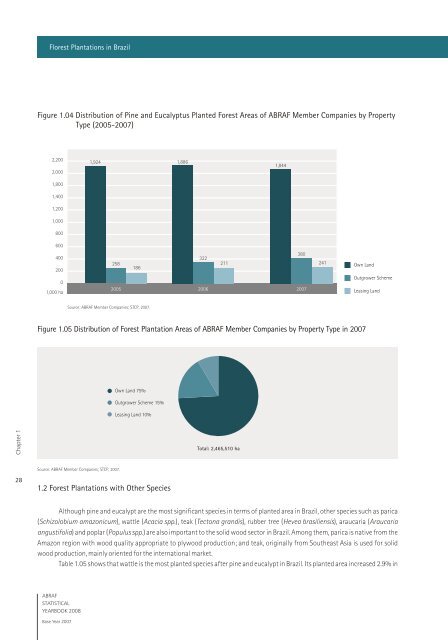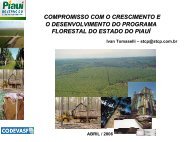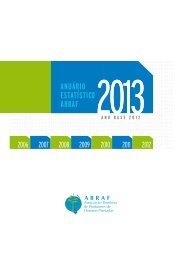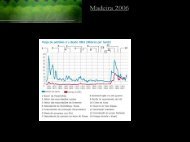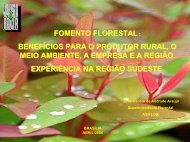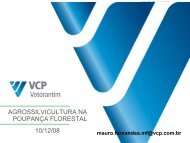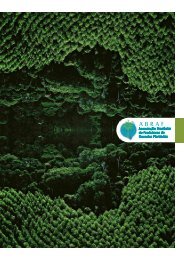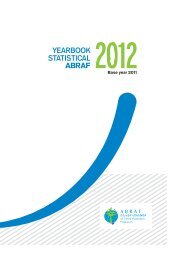Regarding the forest plantation distribution by property type among <strong>ABRAF</strong> member companies, the total plantation areaon their own land reduced 2% from 2006 to 2007, but forest outgrowing scheme and leasing land areas increased 18% and 14%,respectively (Table 1.04). It should be noted that the increasing timber <strong>de</strong>mand by <strong>ABRAF</strong> member companies has been supplied notonly by expanding their own planted forest area, but also by the increasing forest productivity (MAI – Mean Annual Increment), byconducting stand reform, incorporating new technologies, introducing seeds from selected species and cloned seedlings. Besi<strong>de</strong>sthat, <strong>ABRAF</strong> member companies have been searching new areas for leasing and forest outgrowing scheme to supply their increasinglog <strong>de</strong>mand.<strong>ABRAF</strong> member companies in the state of Amapá respon<strong>de</strong>d for 5% of <strong>ABRAF</strong> plantations in 2006 (60,000 ha), while in 2007the participation dropped to zero. That is due, partly, to the fact that forest areas of an <strong>ABRAF</strong> member company was sold in 2006 to anon-<strong>ABRAF</strong> member company in 2007.São Paulo, Bahia and Amapá have shown reduction in the total forest planted area among <strong>ABRAF</strong> member companies, aspresented in Table 1.01. Area with eucalypt plantations in São Paulo remained almost unaltered in 2007, in comparison with 2006figure, with a slight reduction of only 0.4% This fact is, partly, explained by the reduction of areas in the state for some companieswhich have invested in new forest areas in other regions of Brazil.On the other hand, Bahia and Amapá presented significant reductions in pine areas in 2007, <strong>de</strong>creasing 24.8% and 56.1%,respectively, compared to the previous year. These refer to old, not properly managed pine plantation areas. It is worth to mention thatthese pine plantations have been gradually replaced by eucalypt due to their low pine productivity in those regions.In Rio Gran<strong>de</strong> do Sul and Mato Grosso do Sul, there was a significant increase in forest plantations on own land by <strong>ABRAF</strong>member companies, 24% and 12%, respectively, in view of ongoing new planting and Greenfield projects by some members.As for the forest plantations un<strong>de</strong>r outgrowing scheme, Santa Catarina presented the highest rate of increase with 56% from2006 to 2007. Among the states, the forest outgrowing area reduced only in Rio Gran<strong>de</strong> do Sul state (-8%) among <strong>ABRAF</strong> members.On the other hand, Mato Grosso do Sul stood out with the highest increase of plantations in leased land, reaching a 50% increase in2007 compared to 2006.Figure 1.04 shows the trend of distribution of pine and eucalypt plantations among <strong>ABRAF</strong> member companies by propertytype. The data show a gradual reduction of forest plantations in own land, and the consequent increase in leased land areas and forestoutgrower schemes.In 2007, the area distribution by property type was 75% on own land, 15% un<strong>de</strong>r outgrower schemes, and 10% with specialcontracts/leasing areas, as shown in Figure 1.05.27<strong>ABRAF</strong><strong>STATISTICAL</strong><strong>YEARBOOK</strong> 2008Base Year 2007
Florest Plantations in BrazilFigure 1.04 Distribution of Pine and Eucalyptus Planted Forest Areas of <strong>ABRAF</strong> Member Companies by PropertyType (2005-2007)2,2002,0001,9241,8861,8441,8001,4001,2001,00080060040020001,000 ha258380322211241Own Land186Outgrower Scheme2005 2006 2007Leasing LandSource: <strong>ABRAF</strong> Member Companies; STCP, 2007.Figure 1.05 Distribution of Forest Plantation Areas of <strong>ABRAF</strong> Member Companies by Property Type in 2007Own Land 75%Outgrower Scheme 15%Leasing Land 10%Chapter 1Total: 2,465,510 haSource: <strong>ABRAF</strong> Member Companies; STCP, 2007.281.2 Forest Plantations with Other SpeciesAlthough pine and eucalypt are the most significant species in terms of planted area in Brazil, other species such as parica(Schizolobium amazonicum), wattle (Acacia spp.), teak (Tectona grandis), rubber tree (Hevea brasiliensis), araucaria (Araucariaangustifolia) and poplar (Populus spp.) are also important to the solid wood sector in Brazil. Among them, parica is native from theAmazon region with wood quality appropriate to plywood production; and teak, originally from Southeast Asia is used for solidwood production, mainly oriented for the international market.Table 1.05 shows that wattle is the most planted species after pine and eucalypt in Brazil. Its planted area increased 2.9% in<strong>ABRAF</strong><strong>STATISTICAL</strong><strong>YEARBOOK</strong> 2008Base Year 2007


